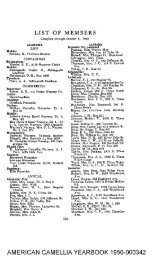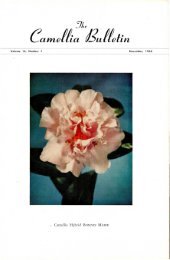CAMELLIA JAPONICA - GOVERNOR EARL WARREN - Immense ...
CAMELLIA JAPONICA - GOVERNOR EARL WARREN - Immense ...
CAMELLIA JAPONICA - GOVERNOR EARL WARREN - Immense ...
Create successful ePaper yourself
Turn your PDF publications into a flip-book with our unique Google optimized e-Paper software.
16 Northern California Camellia Society<br />
CUNNINGHAME'S <strong>CAMELLIA</strong>S IN THE SLOANE HERBARIUM<br />
By H. Harold Hume, President Emeritus<br />
American Camellia Society<br />
Nearly two and a half centuries<br />
ago camellias were introduced to the<br />
western botanical-horticultural world.<br />
To be exact, the date was 1702. In<br />
that year, James Petiver, a London<br />
apothecary whose place of business<br />
was on Aldersgate Street, presented<br />
a paper at a meeting of the Royal<br />
Society in which he described a camellia<br />
and in his own publication,<br />
entitled "Gasophylacii Naturae and<br />
Artis," illustrated it. The description<br />
he gave is as follows:<br />
"93. Thea CHINENSIS Pimentae Jamaicensis<br />
folio, flore Rosaceo simplici<br />
Gaz. nost. Nat. Tab. 33. Fig 4.<br />
"Swa Tea s. Cha hoa Chinens.<br />
Herb. nost. Chin. pict. Tab. vi. Fig. xi.<br />
"Hoa in the Chinese Language signifies<br />
a Flower; and this Plant has a<br />
very beautiful one, for which reason<br />
and the variation of them (some being<br />
single and of a deep red as this, others<br />
white and some strip'd, there are<br />
also of these Colours with double<br />
Flowers) they and the Japoneze keep<br />
them as an Ornament in their Gardens.<br />
"Of these Leaves some are rounder,<br />
others pointed, they have the shape<br />
and stiffness of the Allspice or Jamaica<br />
Pepper, are somewhat serrated<br />
and grow irregularly on short thick<br />
footstalks, the young Flower-bud is<br />
scal'd like a Cone, when larger the<br />
squama are whitish and Velvetty,<br />
except the edges which are brown<br />
and transparent. The Flowers deep<br />
red, 5 Leaved and as big as a single<br />
Rose, and like it full of threads with<br />
yellow spices or beads. The Fruit<br />
about the bigness of a Chestnut,<br />
somewhat triangular, including under<br />
a very thick woody shell several<br />
seeds disposed into 3 Cells. It flowers<br />
in February."<br />
Petiver's illustration of camellia in<br />
the Gazophylacii consists of a twig<br />
with four leaves, two flower buds<br />
and two flowers, one with a side<br />
view, the other full face.<br />
Where did Petiver obtain the information<br />
on camellias contained in<br />
his paper in the Philosophical Transactions<br />
of the Royal Society? He<br />
stated clearly, in the heading of his<br />
article, where it came from, in part<br />
at least. The title is as follows,- "A<br />
description of some coralls and other<br />
curious Submarines lately sent to<br />
James Petiver, apothecary, and Fellow<br />
of the Royal Society, from the<br />
Philippine Isles by the Reverend<br />
George Joseph Cammel; as also an<br />
account of some plants from Chusan<br />
an Island on the coast of China; collected<br />
by James Cunninghame, Chyrugen<br />
& F.R.S." It is with the latter<br />
part of the this title that we are concerned<br />
here.<br />
The paper in question, presented<br />
in 1702 and published in the Transactions<br />
in 1704, has this subheading,<br />
"The Chusan plants received from<br />
Mr. James Cunninghame are as follows"<br />
and item 93 is the camellia<br />
description already quoted. A careful<br />
reading of this description leads to<br />
the conclusion that Petiver could not<br />
have written it without help from<br />
some one who had seen the camellia<br />
plants growing and in flower and fruit<br />
and that person probably was James<br />
Cunninghame (also spelled without<br />
the final e.)<br />
Petiver maintained a museum and<br />
the dried specimens of the camellia,<br />
as well as many other plants, were<br />
part of that museum. It must have<br />
been a collection of size and importance<br />
for at one time Sir Hans Sloane<br />
offered Petiver £4000 for it, a large<br />
amount of money in those days. After<br />
the death of Petiver in 1718, his museum<br />
passed into the hands of Sir<br />
Hans Sloane, celebrated physician<br />
and botanist, to become, later, part of<br />
the Sloane collections with which the<br />
British Museum (Natural History) was<br />
opened in London in 1759.<br />
There are four specimens of what<br />
now is known as Camellia iaponica<br />
,1<br />
1 I




